Understanding Pressure Points and Their Role in Sleep

The concept of pressure points, integral to traditional Chinese medicine (TCM), posits that the human body is traversed by a network of energy pathways known as meridians. These meridians are thought to be conduits for the flow of “qi” or life energy, which sustains health and vitality. Pressure points, or acupoints, are specific locations along these meridians where the qi is accessible and can be manipulated through various techniques, including acupressure, acupuncture, and massage (Takahashi, 2006).
Scientific Basis and Effectiveness
Modern research has begun to explore the efficacy of stimulating pressure points in treating various health conditions, including insomnia. A systematic review and meta-analysis by Yeung et al. (2018) demonstrated that acupuncture and acupressure are effective in improving sleep quality among individuals with insomnia. These findings suggest that manipulating specific pressure points can indeed influence sleep patterns, potentially offering a non-invasive alternative to conventional treatments.
Mechanism of Action
Experts believe that stimulating pressure points improves sleep through several physiological processes, although the exact mechanisms are not fully understood.One theory is that stimulating acupoints may induce the release of endorphins and neurotransmitters like serotonin, which play roles in mood regulation and sleep (Lee, et al., 2009). Additionally, acupressure and acupuncture are believed to decrease sympathetic nervous system activity, promoting relaxation and making it easier to fall asleep (Spence et al., 2004).
Identifying and Stimulating Pressure Points
To find pressure points, use anatomical landmarks and typically apply gentle but firm pressure or use circular massage motions to stimulate them.The practice does not require any special equipment and can be performed at home as part of a bedtime routine to help alleviate insomnia.
What are 5 pressure points?
There are over 300 pressure points in the body, but not all of them are related to sleep. Following are 5 basic acupressure points for sleep. Some professionals will tell you that there are more than 5 pressure points, so some stimulate 6, 7 or 8 points, but these 5 are the most proven.
Pressure Point 1: Spirit Gate (HT-7)
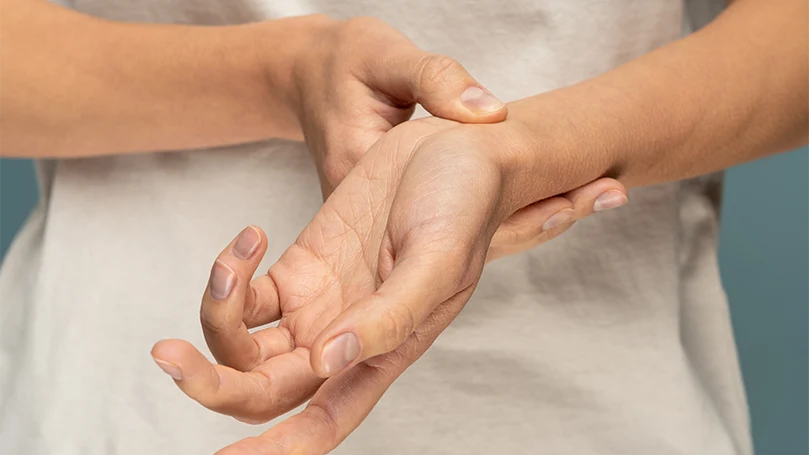
The Spirit Gate, known in traditional Chinese medicine as HT-7, is a pivotal acupoint for emotional and mental well-being, particularly effective in treating stress, anxiety, and, crucially, insomnia. Located on the inner wrist, it serves as a gateway to calming the mind and promoting deep, restorative sleep.
Location and Identification
You can find HT-7 on the front side of the wrist, right in the crease where the hand joins the arm, perfectly aligned with the little finger. To precisely locate the Spirit Gate, place your thumb on the inner wrist crease and feel for a small depression near the base of the ulnar bone—the point lies within this depression.
Stimulation Method
To stimulate the Spirit Gate:
- Apply gentle yet firm pressure to the HT-7 point with the thumb of your opposite hand.
- Massage the point in a circular motion for 2 to 3 minutes.
- Breathe deeply as you focus on the pressure, aiming to relax your mind and body.
- Perform this stimulation in the evening, before bedtime, to help ease into a peaceful state conducive to sleep.
Expected Outcomes
According to traditional Chinese medicine theory, stimulating the Spirit Gate can help release pent-up emotions, reduce anxiety, and facilitate the transition into sleep by calming the spirit. Research supports the use of acupressure at HT-7 for improving sleep quality. A study by Yeung, Chung, and Poon (2012) found that acupressure on HT-7 significantly improved sleep quality in participants with insomnia, suggesting that regular stimulation of this point might reduce the time it takes to fall asleep and increase sleep duration.
Scientific Evidence
Stimulating HT-7 is believed to finely tune the autonomic nervous system, effectively dialing down stress levels. This process significantly boosts relaxation, priming the body for a restful sleep. (Chung et al., 2012). Additionally, acupressure at this point may influence the endocrine system, regulating cortisol levels, which play a crucial role in sleep cycles (Lee, et al., 2009).
Pressure Point 2: Three Yin Intersection (SP-6)
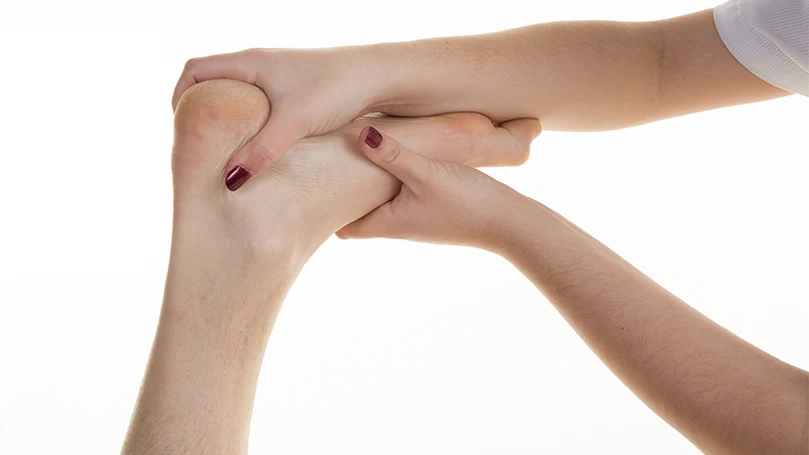
The Three Yin Intersection, or SP-6, is an essential acupoint in traditional Chinese medicine for harmonizing the body's internal systems and is highly regarded for its multifaceted benefits, including supporting sleep, reducing stress, and balancing hormones. This pressure point is unique as it intersects the liver, spleen, and kidney meridians, making it particularly effective for issues related to emotional imbalance and insomnia.
Location and Identification
SP-6 is located on the inner leg, just above the ankle. To find it, measure four finger widths up from the inner ankle bone. The point is located just off the shin bone (tibia), in a soft area surrounded by the bone and the muscle.
Stimulation Method
To stimulate the Three Yin Intersection:
- Sit comfortably or lie down, exposing the inner leg.
- Use your thumb or fingertip to apply gentle but firm pressure to the SP-6 point.
- Massage the area in a circular motion for 2 to 3 minutes, focusing on deep, relaxed breathing.
- For insomnia, it's best to perform this in the evening before bedtime to help calm the mind and promote a sense of relaxation.
Expected Outcomes
Stimulating SP-6 is believed to have a calming effect on the mind and body, facilitating the transition into sleep. It's especially beneficial for those whose insomnia is related to stress, hormonal imbalances, or menstrual discomfort, as it works to harmonize the body's energy and promote inner peace.
Scientific Evidence
Research supports the use of SP-6 stimulation for improving sleep quality and duration. A study by Hwang et al. (2010) found that acupressure on the SP-6 acupoint significantly improved sleep quality in postmenopausal women, suggesting that this practice can be an effective non-pharmacological intervention for insomnia. People believe that acupuncture balances the body's energy and regulates hormonal functions, which are essential for maintaining sleep health.
Pressure Point 3: Anmian

Anmian is the only acupoint specifically designated for sleep in traditional Chinese medicine, aptly named for its direct translation to “peaceful sleep.” Unlike other points, Anmian does not lie on a specific meridian but is renowned for its effectiveness in treating insomnia, anxiety, and stress, making it a crucial point for those seeking natural remedies for sleep disturbances.
Location and Identification
The Anmian point is located near the ear, on the side of the neck. To find it, place your finger behind the earlobe, at the base of the skull, and move your finger slightly towards the back along the hairline. The point is approximately midway between the earlobe's base and the spine's prominence at the back of the neck.
Stimulation Method
To stimulate the Anmian point:
- Lie down or sit in a comfortable position, exposing the sides of your neck.
- Use your fingertips to gently press or massage the Anmian area in a circular motion.
- Continue the stimulation for 2 to 3 minutes, focusing on deep, relaxing breaths.
- This technique can be performed on both sides of the neck and is most effective when done before bedtime to encourage deep, restful sleep.
Expected Outcomes
Stimulating the Anmian point is believed to calm the mind, reduce stress, and alleviate mental fatigue, which contributes to better sleep quality and duration. By promoting relaxation and easing nervous tension, activating this point can help facilitate a smoother transition into sleep.
Scientific Evidence
While direct research on the Anmian point is limited compared to other acupoints, its use is supported by traditional practices and anecdotal evidence within the scope of traditional Chinese medicine (TCM) for promoting sleep and reducing stress. The effectiveness of Anmian stimulation for sleep enhancement is often attributed to its role in calming the nervous system and facilitating mental relaxation, principles that are foundational in TCM and increasingly recognized in holistic health practices.
Pressure Point 4: Inner Frontier Gate (PC-6)
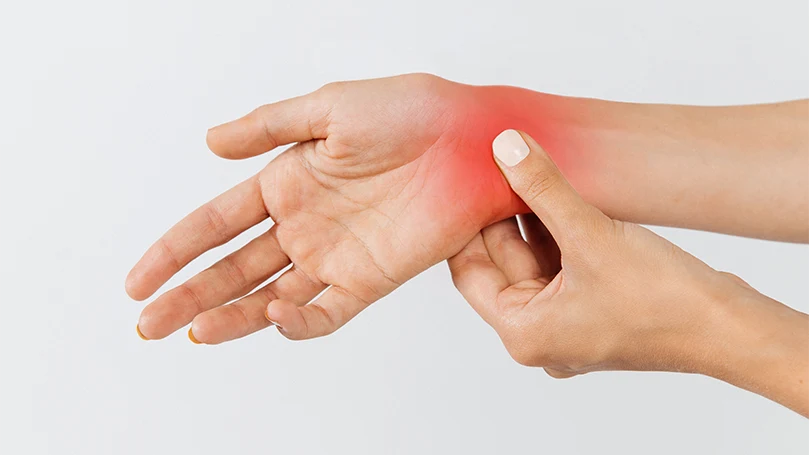
The Inner Frontier Gate, known in traditional Chinese medicine as PC-6, is a powerful acupoint for addressing emotional distress, nausea, and particularly, sleep disturbances. Its effectiveness in calming the mind and soothing the stomach makes it an invaluable point for those whose insomnia may be compounded by anxiety or digestive issues.
Location and Identification
PC-6 is located on the inner forearm, approximately three finger widths below the wrist crease, in the space between the tendons of the palmaris longus and flexor carpi radialis muscles. To locate it, place your three fingers (index to ring finger) on the wrist crease and find the point where your third finger touches.
Stimulation Method
To effectively stimulate the Inner Frontier Gate:
- Sit in a relaxed position and expose the inner forearm.
- With the thumb of your opposite hand, apply firm but gentle pressure to the PC-6 point.
- Massage the point in small circular motions or apply steady pressure for 2 to 3 minutes.
- Deep, calm breathing during the stimulation can enhance relaxation effects.
- This acupoint can be stimulated at any time but is particularly effective before bedtime to alleviate stress and promote a peaceful state conducive to sleep.
Expected Outcomes
Stimulating the PC-6 pressure point can improve sleep quality by balancing emotions, reducing heart palpitations, and easing stomach issues. By addressing both physical and emotional aspects of insomnia, PC-6 offers a holistic approach to improving sleep.
Scientific Evidence
The efficacy of PC-6 stimulation for enhancing sleep has been documented in various studies. For instance, research has shown that acupressure on PC-6 can reduce anxiety levels and improve sleep quality in patients undergoing surgery (Wu, Dong-Jie 2018). These effects are attributed to the point's role in modulating the autonomic nervous system, thereby inducing relaxation and reducing stress.
Pressure Point 5: Wind Pool (GB-20)
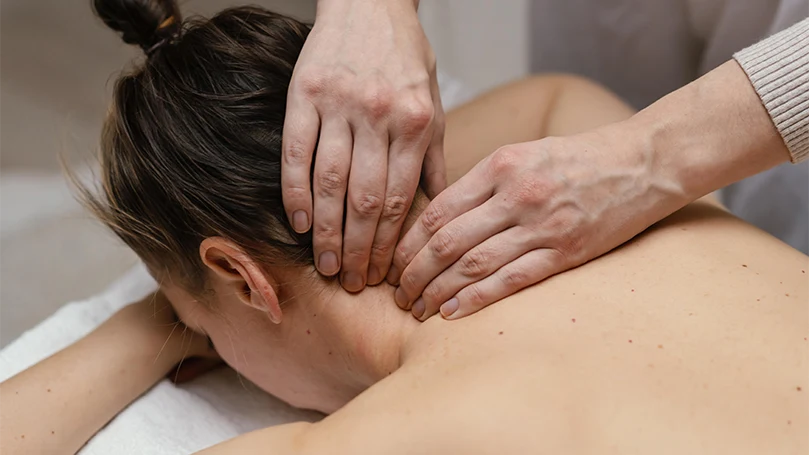
The Wind Pool, or GB-20, is another crucial acupoint in the arsenal against insomnia, particularly known for its effectiveness in relieving stress, neck tension, and headaches, all of which can contribute to sleep difficulties. Situated at the base of the skull, this point is especially beneficial for those whose insomnia is accompanied by tension and discomfort.
Location and Identification
GB-20 is located at the back of the neck, in the depressions found on both sides of the spine, beneath the base of the skull, and approximately two finger widths away from the midline of the neck. The two major muscles of the neck (the sternocleidomastoid and the trapezius) nestle the points between them.
Stimulation Method
To effectively stimulate the Wind Pool:
- Use your fingertips or thumbs to apply firm, gentle pressure to both points simultaneously.
- Rub the points in a circular motion or apply steady pressure for 3 to 4 minutes.
- Close your eyes and breathe deeply, focusing on releasing tension in the neck and head area.
- You can stimulate this acupoint at any time, but we particularly recommend doing it in the evening or right before bed to alleviate stress and prepare the body for sleep.
Expected Outcomes
People believe that stimulating GB-20 clears the mind, eases mental stress, and reduces headaches and neck pain, which can often hinder the onset of sleep.The action of massaging this area can also promote relaxation throughout the body, making it easier to fall asleep.
Scientific Evidence
Research indicates that acupressure at the Wind Pool points can have a sedative effect, potentially by reducing sympathetic nervous system activity, thereby promoting relaxation and sleep (Lee, et al., 2009). A study by Hsieh et al. (2010) demonstrated that regular acupressure treatments on GB-20 significantly improved sleep quality and reduced chronic headaches in participants, suggesting a direct link between the relief of tension headaches and the enhancement of sleep quality.
Conclusion and Tips for Best Practice
Incorporating the stimulation of these five pressure points – Spirit Gate (HT-7), Wind Pool (GB-20), Three Yin Intersection (SP-6), Inner Frontier Gate (PC-6), and Anmian – into your nightly routine may offer a natural and effective way to combat insomnia and improve sleep quality. Each point, with its unique benefits, addresses different aspects of the sleep disturbance puzzle, from emotional stress to physical tension.
For best results, consider the following tips:
- Consistency is key. Regular stimulation of these points can help achieve more significant and lasting improvements in sleep quality.
- Combine acupressure with other sleep hygiene practices, such as maintaining a regular sleep schedule, creating a comfortable sleep environment, and avoiding caffeine and electronics before bedtime.
- Be patient and attentive to your body's responses. While acupressure is beneficial for many, individual experiences may vary.
By understanding and utilizing these pressure points, you can tap into the body's natural healing mechanisms, promoting not only better sleep but also overall well-being. Remember, if sleep problems persist, you should consult a healthcare professional to rule out underlying conditions and receive personalized advice.
This comprehensive exploration of “5 Pressure Points for Sleep – Insomnia Treatment” melds traditional wisdom with modern research, offering a holistic approach to improving sleep and combating insomnia. Whether you're seeking alternatives to medication or looking to enhance your sleep hygiene regimen, these techniques provide a valuable resource for achieving a more restful and rejuvenating night's sleep.
Spread the word
Recommended reading:

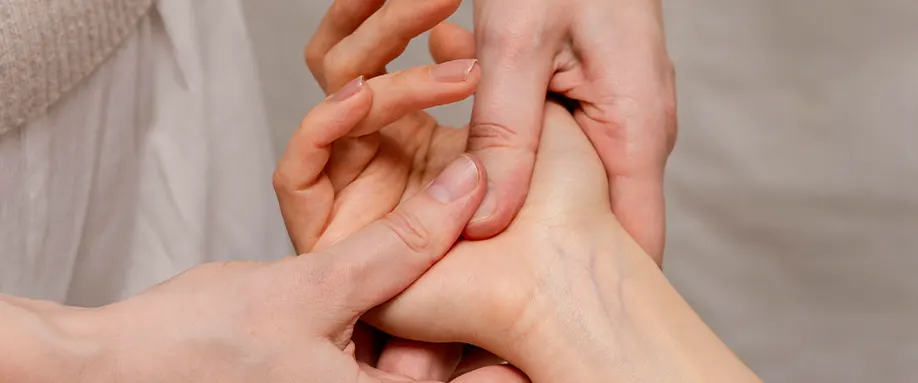













There are no comments yet
"*" indicates required fields